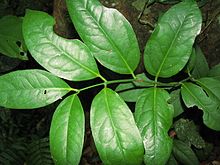Austrobaileya
| Austrobaileya | |
|---|---|

| |
| Branch, Wooroonooran National Park, Queensland, Australia | |
| Scientific classification | |
| Kingdom: | Plantae |
| Clade: | Tracheophytes |
| Clade: | Angiosperms |
| Order: | Austrobaileyales |
| Family: | Austrobaileyaceae Croizat[2][3] |
| Genus: | Austrobaileya C.T.White |
| Species: | A. scandens
|
| Binomial name | |
| Austrobaileya scandens C.T.White[1]
| |
| Synonyms[4] | |
|
Austrobaileya maculata C.T.White | |
Austrobaileya is the sole genus consisting of a single species that constitutes the entire flowering plant family Austrobaileyaceae.[3][1][4][5][6][7] The species Austrobaileya scandens grows naturally only in the Wet Tropics rainforests of north eastern Queensland, Australia.[1][4][7][8][9]
The name A. maculata is recognized as a synonym of A. scandens.[1][4]
Austrobaileya plants grow as woody lianas or vines. Their main growing stems loosely twine, with straight, extending, leafy branches. The leaves are leathery, veined and simple. The leaves produce essential oils in spherical ethereal oil cells. Their foliage is damaged by oxidation in direct sunlight, so it tends to grow beneath the rainforest canopy, in low-sunlight and very humid conditions.[10] Like many other flowering plants growing in the understory of tropical rainforest, it does not have palisade mesophyll tissue or low leaf photosynthetic rates. It relies strongly on vegetative reproduction for continuation of the species.[citation needed]
Austrobaileya scandens
Austrobaileya scandens is a rare species found only (endemic) in the Wet Tropics rainforests of Queensland. It is the oldest species of flowering plants in Australia that requires pollination. Austrobaileya is one of many ancient ('basal') plants found in Wet Tropics that have survived millions of years of climatic and geological changes.
The species is well adapted to rainforests, where it can wind around tall woody trees that form the canopy. It is evolved for fitness in the wet tropical rainforest’s conditions of dampness, humidity, high-light canopy and low-light understory.
It can grow up to 15 metres (49 ft) tall. The plant has a distinctive blue-green colour foliage. Austrobaileya has large and solitary flowers that are arranged in a spiral with pale green petals. Flowers are pollinated by flies. To attract pollinators, A. scandens’ flowers release a rotting fish smell.
Their fruits are apricot-coloured and contain tightly packed seeds, similar in shape to chestnuts. The fruit is shaped like a pear or eggplant. Fruits have been known to grow to sizes of 7 centimetres (2.8 in) in length by 5 centimetres (2.0 in).
Austrobaileyaceae family classification
The APG IV system, of 2016 (and the earlier 2009 APG III system and 2003 APG II system), recognise this Austrobaileyaceae family, placing it in the Austrobaileyales order. Austrobaileyales is accepted as being among the most basal lineages in the clade angiosperms.[2][11][12]
The Cronquist system, of 1981, assigned the family to the order Magnoliales, in subclass Magnoliidae, in class Magnoliopsida [=dicotyledons] of division Magnoliophyta [=angiosperms].
The Thorne system (1992) placed it in the order Magnoliales, which was assigned to superorder Magnolianae, in subclass Magnoliideae [=dicotyledons], in class Magnoliopsida [=angiosperms].
The Dahlgren system assigned it to the order Annonales, which was placed in superorder Magnolianae, in subclass Magnoliideae [=dicotyledons], in class Magnoliopsida [=angiosperms].
The Engler system, in its update of 1964, assigned it to the order Magnoliales, which was placed in subclass Archychlamydeae in class Dicotyledoneae and in subdivision Angiospermae
References
- ^ a b c d "Austrobaileya%". Australian Plant Name Index (APNI), Integrated Botanical Information System (IBIS) database (listing by % wildcard matching of all taxa relevant to Australia). Centre for Plant Biodiversity Research, Australian Government. Retrieved 26 Apr 2013.
- ^ a b The Angiosperm Phylogeny Group (2009). "An update of the Angiosperm Phylogeny Group classification for the orders and families of flowering plants: APG III". Botanical Journal of the Linnean Society. 161 (2): 105–121. doi:10.1111/j.1095-8339.2009.00996.x. ISSN 1095-8339. Retrieved 9 Mar 2013. See APG III system
- ^ a b Stevens, Peter F. (Sep 2013) [2001 onwards]. "Angiosperm Phylogeny Website – Austrobaileyaceae". Version 13, 28 Sep 2013 with updates. Retrieved 7 Dec 2014.
- ^ a b c d
Ross, E. M. (1989). Plant profile Austrobaileya scandens C.T.White. Vol. 3. pp. 163–165. JSTOR 41738747.
{{cite book}}:|journal=ignored (help) - ^ Mabberley, David J. (May 2008). Mabberley's Plant-book: A Portable Dictionary of Plants, Their Classifications, and Uses (3rd, revised, illustrated ed.). Cambridge, UK: Cambridge University Press. p. 81. ISBN 9780521820714.
- ^ Hyland, B. P. M.; Whiffin, T.; Zich, F. A.; et al. (Dec 2010). "Factsheet – Austrobaileyaceae". Australian Tropical Rainforest Plants (6.1, online version RFK 6.1 ed.). Cairns, Australia: Commonwealth Scientific and Industrial Research Organisation (CSIRO), through its Division of Plant Industry; the Centre for Australian National Biodiversity Research; the Australian Tropical Herbarium, James Cook University. Retrieved 10 Mar 2013.
- ^ a b "Austrobaileya C.T.White". Flora of Australia Online. Department of the Environment and Heritage, Australian Government.
- ^ "Austrobaileya scandens C.T.White". Flora of Australia Online. Department of the Environment and Heritage, Australian Government.
- ^ Hyland, B. P. M.; Whiffin, T.; Zich, F. A.; et al. (Dec 2010). "Factsheet – Austrobaileya scandens". Australian Tropical Rainforest Plants (6.1, online version RFK 6.1 ed.). Cairns, Australia: Commonwealth Scientific and Industrial Research Organisation (CSIRO), through its Division of Plant Industry; the Centre for Australian National Biodiversity Research; the Australian Tropical Herbarium, James Cook University. Retrieved 10 Mar 2013.
- ^ Raven, Peter H. (2013). Biology of Plants. New York, NY: W.H. Freeman and Company Publishers. p. 480. ISBN 9781429219617.
- ^ Soltis, Douglas E.; Smith, Stephen A.; Cellinese, Nico; et al. (Apr 2011). "Angiosperm phylogeny: 17 genes, 640 taxa". American Journal of Botany. 98 (4): 704–730. doi:10.3732/ajb.1000404. ISSN 1537-2197. PMID 21613169. Retrieved 10 Mar 2013.
- ^ Angiosperm Phylogeny Group (2016). "An update of the Angiosperm Phylogeny Group classification for the orders and families of flowering plants: APG IV" (PDF). Botanical Journal of the Linnean Society. 181 (1): 1–20. doi:10.1111/boj.12385. ISSN 0024-4074.
